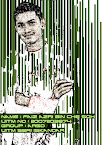SEMESTER 5 / PROJECT 2 : YOUTH SPACE.
SECOND PROJECT : ART@WORKSPACE, DESIGN @ STUDIO @ YOUTH SPACE.
----------------------------------------------------------------------------------------------------
ABSTRACT
----------------------------------------------------------------------------------------------------
the burgeoning population in the inner cities and the resulting social problems are part of a complex urban phenomenon. the saturation point where the environmental psychological aspect of overcrowding arises could be most felt in the urban low cost housing area, where the high density of people creates social tension. as it is, the spatial quality of housing unit is not conducive as the built up area is ridiculously low. this created the space deficit factor, whereby the children, especially the teenagers are subtly 'push out' from their own homes due to lack of personal space and privacy. so where do the youth go? in search of a sense of identity, they tend seek it among their peers. their social needs are fulfilled outside parental control and this could lead to either positive or negative impact. some the inner cities youth are delinquents like the "mat rempit" were infamously qouted as saying that their daredevil acts were due to the feeling of boredom. thus, the popularity of the internet's social networking sites such as a Twitter, Myspace, and Facebook among youths ; which is understandable as they act as mediums to relate and network with others. architecture could also play positive role in producing physical space for creative activities which benefited the urban youths. it should be a place which is meaningful to them, where they can be themselves and the day-to-day running of the place and its activities are managed by them. hypothetically, the youth could become productive if they are given the right environment, responsibility and a sense of belonging.
-------------------------------------------------------------------------------------------------
SITE ANALYSIS
-------------------------------------------------------------------------------------------------
-------------------------------------------------------------------------------------------------
ACTIVITY FOR YOUTH SPACE : LE PARKOUR
-------------------------------------------------------------------------------------------------
Parkour (sometimes also abbreviated to PK) or l'art du déplacement [1] (English: the art of moving) is a physical discipline of French origin in which participants run along a route, attempting to negotiate obstacles in the most efficient way possible, as if moving in an emergency situation, using skills such as jumping and climbing, or the more specific parkour moves. The object is to get from one place to another using only the human body and the objects in the environment around you. The obstacles can be anything in one's environment, but parkour is often seen practiced in urban areas because of the many suitable public structures that are accessible to most people, such as buildings and rails.
The official definition from the American Parkour website says, "Parkour is the physical discipline of training to overcome any obstacle within one's path by adapting one's movements to the environment."
Parkour practitioners are often called traceurs if male, or traceuses if female.





-------------------------------------------------------------------------------------------------
THE DRAWING. -------------------------------------------------------------------------------------------------





-------------------------------------------------------------------------------------------------
THE MODEL.
-------------------------------------------------------------------------------------------------






-------------------------------------------------------------------------------------------------























.jpg)
.jpg)
.jpg)
.jpg)
.jpg)
.jpg)

.jpg)
.jpg)
.jpg)
.jpg)
.jpg)
.jpg)
.jpg)
.jpg)












